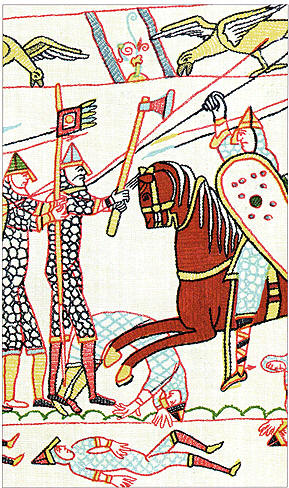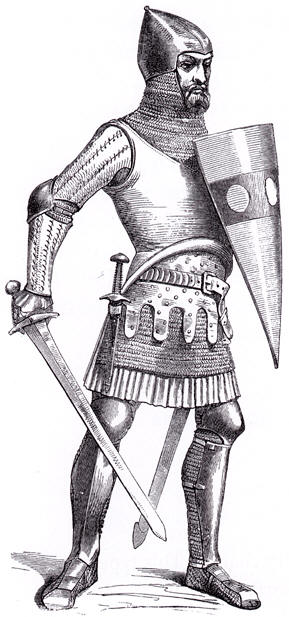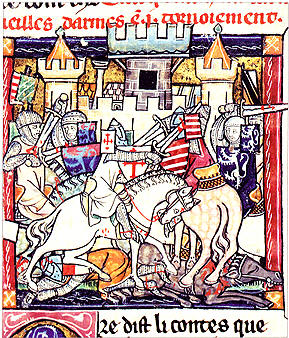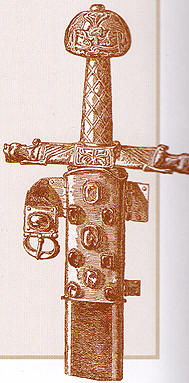Medieval Weapons
Feudal armies in Europe from
the 11th to the 14th century produced a core group
of premium fighting men
— the mounted knights.
Over time, they became more heavily armored and
reliant upon the shattering force of horse, lance
and wide-bladed sword. In their wake, massed ranks
of foot-soldiers engaged the enemy with long
polearms (essentially weapons mounted on the end of
a long pole), hoping to dismount and finish off any
enemy knight. The fighting was brutal and bloody,
conducted in a crush of jabbing, thrusting weapons.
1066 - The
Battlefield
 The
Battle of Hastings (1066) saw William of Normandy
(c.1028—1087)
unleash the devastating power of his heavily
armoured knights for the first time on British soil.
During many hours of hard fighting, King Harold II
(c.
1022—1066) and his
fellow Anglo-Saxon defenders were constantly harried
by repeated Norman cavalry charges. This type of
mounted and mobile warfare was unknown to the
Anglo-Saxons, who were predominantly foot soldiers,
and it was only their fortunate selection of
superior and defensible terrain prior to the battle
that stopped them from being immediately
overwhelmed. The
Battle of Hastings (1066) saw William of Normandy
(c.1028—1087)
unleash the devastating power of his heavily
armoured knights for the first time on British soil.
During many hours of hard fighting, King Harold II
(c.
1022—1066) and his
fellow Anglo-Saxon defenders were constantly harried
by repeated Norman cavalry charges. This type of
mounted and mobile warfare was unknown to the
Anglo-Saxons, who were predominantly foot soldiers,
and it was only their fortunate selection of
superior and defensible terrain prior to the battle
that stopped them from being immediately
overwhelmed.
RIGHT:
In
this detail from the Bayeux Tapestry, Harold Ii’s
Anglo-Saxon troops, led by an armoured standard
bearer and a warrior with an axe, confront a Norman
cavalryman armed with a lance.
The Norman War
Sword
A double-edged, razor-sharp
broadsword with an average length of around 75cm
(29.5in), was the main battle weapon of the Norman
knight of the medieval period. It was ideal for
swinging at speed and downward slashing. It would be
used one-handed and in conjunction with a large,
kite-shaped shield.

ABOVE:
This sword is a “transitional” piece
between the Viking and medieval period. It has a
distinctive “brazil nut” pommel that was common in
the early medieval period and the cross guard has
increased considerably in width, while the blade is
also more finely tapered.
The Norman
Lance
Although it is called a
lance, Norman knights used what could more
accurately be described as a long, wooden spear with
a simple, spiked end. It would be held firmly under
the arm in order that the maximum force of both man
and horse could be transmitted into the charge. Once
the enemy had been engaged, the lance could also be
transformed into an effective close-combat thrusting
weapon, or simply thrown.
 The
“Knightly” or “Arming” Sword The
“Knightly” or “Arming” Sword
During a period when there
was a practical need for a substantial and sturdy
fighting weapon on the battlefield, the medieval
“knightly” or “arming” sword was carried. Most
battles in Europe took the form of two heavily armed
and armored scrums locked in a frenetic
life-or-death struggle to push the enemy back,
coupled with the added difficulty of trying to kill
or maim as many enemies as possible in a very
limited amount of space. It was quite common for
soldiers to be literally crushed to death by their
own side as the battle moved along.
Sword Manufacture
Before the 9th century good sources of quality iron
ore were not always available and many swords were
often forge-welded from a selection of smaller iron
pieces, thus reducing the inherent strength of the
blade. Conversely, swordsmiths also forged
high-quality swords using a process known as pattern
welding, using rods of superior iron. The process
required that the rods be tightly twisted together,
so creating a much stronger and more durable blade
with great qualities of tempering. The interlocking
of these rods under great heat, and their sudden
cooling and hammering, created distinctive forging
patterns on the blade’s surface. This diversity of
swirling patterns was highly prized by an owner.
RIGHT:
A 13th-century French soldier. He carries a double-
edged broadsword with brazil nut pommel and
down-sloping cross guard.
By the 9th century in Europe, the blast furnace
became widespread and the need for pattern welding
diminished. During the centuries that followed, the
technique was slowly lost, and by 1300 there are few
examples of its use. The technique survived,
however, in Scandinavia, where good quality iron
ores and charcoal were widely available.

ABOVE:
William the Conqueror, accompanied by knights and
soldiers, from a page of illustrated Latin text from
the 14th century.
 The
typical style of the “knightly” or “arming” sword
was firmly established by the 12th and 13th
centuries. In general terms, it comprised a long,
broad-bladed cutting and thrusting sword with double
fullers (beveled grooves); a plain crossbar hilt;
and a wheel, brazil nut, ovoid or mushroom- shaped
pommel. This sword design had remained virtually
unchanged since the Viking invasions (AD793—c.
1066), and over the next three centuries there was
to be little innovation. Most blades and hilts were
plain, although some surviving blades are found with
inlaid decoration, mostly in the form of large,
punched lettering or symbols, normally of a
religious or mystical nature. Pommels of this period
can also be found with inset heraldic devices,
denoting particular royal or noble families. Rare
specimens have pommels of agate, inlaid gold or rock
crystal. The
typical style of the “knightly” or “arming” sword
was firmly established by the 12th and 13th
centuries. In general terms, it comprised a long,
broad-bladed cutting and thrusting sword with double
fullers (beveled grooves); a plain crossbar hilt;
and a wheel, brazil nut, ovoid or mushroom- shaped
pommel. This sword design had remained virtually
unchanged since the Viking invasions (AD793—c.
1066), and over the next three centuries there was
to be little innovation. Most blades and hilts were
plain, although some surviving blades are found with
inlaid decoration, mostly in the form of large,
punched lettering or symbols, normally of a
religious or mystical nature. Pommels of this period
can also be found with inset heraldic devices,
denoting particular royal or noble families. Rare
specimens have pommels of agate, inlaid gold or rock
crystal.
RIGHT:
The knights Galahad and Gawain are pictured taking
part in a tournament, from La Queste el Saint
Graal, c.1316. The knights wield wide-bladed,
slashing swords typical of this period.
Swords would have been pattern
forged or “braided” in the manner of earlier Viking
swords, making them excellent fighting weapons
— very strong and not
prone to breakage. Swords were normally combined
with either a large shield or buckler (small
shield), although there are many contemporary images
and written descriptions that describe the use of
the knightly sword without a shield. This was
thought to enable the free hand to grab or grapple
with opponents. A knight would have worn this large
sword whether in armor or not. He would have been
considered “undressed” without his sword.
Medieval
Ceremonial Swords
 Swords
produced specifically for use at royal coronations
and similar ceremonies began to appear from the 11th
century onwards. They were not designed for battle
and were kept safely in churches, palaces and state
arsenals. Decoration was profuse and the scale was
deliberately large and impressive. One of the swords
of Charlemagne (or Charles the Great), King of the
Franks (r AD742—814), is preserved in the
Schatzkammer (Treasury) in Vienna. The blade is
single-edged, slightly curved and overlaid with
copper decoration, including dragon motifs. Hilt and
scabbard are covered in silver gilt. The grip is
wrapped in fishskin, set at an angle and very
reminiscent of Near Eastern swords of the period.
The second sword sometimes attributed to Charlemagne
is found in the Louvre, Paris. The ornamentation on
the hilt suggests it was carried by him, but it was
also known to have been used as a ceremonial sword
when Philip the Bold was crowned in 1270. Swords
produced specifically for use at royal coronations
and similar ceremonies began to appear from the 11th
century onwards. They were not designed for battle
and were kept safely in churches, palaces and state
arsenals. Decoration was profuse and the scale was
deliberately large and impressive. One of the swords
of Charlemagne (or Charles the Great), King of the
Franks (r AD742—814), is preserved in the
Schatzkammer (Treasury) in Vienna. The blade is
single-edged, slightly curved and overlaid with
copper decoration, including dragon motifs. Hilt and
scabbard are covered in silver gilt. The grip is
wrapped in fishskin, set at an angle and very
reminiscent of Near Eastern swords of the period.
The second sword sometimes attributed to Charlemagne
is found in the Louvre, Paris. The ornamentation on
the hilt suggests it was carried by him, but it was
also known to have been used as a ceremonial sword
when Philip the Bold was crowned in 1270.
RIGHT:
A
line drawing of one of two swords attributed to
Charlemagne or Charles the Great
(r
AD742—814). The sword is kept in the Louvre Museum
in Paris.

ABOVE:
A
knight’s sword, c.1250—1300, with a narrow blade,
light enough to use on foot. This sword has a
spear-point blade and impressive cutting and
thrusting capabilities.

ABOVE:
A longsword with a highly tapered blade which could
be used to penetrate armor.
The Medieval Sword in Battle
A contemporary Florentine
description of the Battle of Kosovo, between the
Serbs and the Ottoman Empire in 1389, highlights the
“knightly” aspect of the use of the sword and its
perceived retributory power.
Fortunate, most
fortunate are those hands of the twelve loyal
lords who, having opened their way with the
sword and having penetrated the enemy lines and
the circle of chained camels, heroically reached
the tent of Amurat himself
. .
Fortunate above
all is that one who so forcefully killed such a
strong vojvoda by stabbing him with a sword in
the throat and belly. And blessed are all those
who gave their lives and blood through the
glorious manner of martyrdom...
Response from the Florentine Senate
(1389)
The Medieval
Longsword
 A
natural progression from the two-handed “arming” or
“knightly” swords of the early to mid-medieval
period was the first longswords, with the main
difference being an increase in blade length. The
double-edged blade was 80—95cm (31—37 in) long and
weighed in at approximately 1—2kg (2.2—4.4 lb). This
was very much a sword of the late medieval period
and was used from around 1350 to 1550. The length of
the grip was also extended to allow a more powerful
and directed use of two hands, but the traditional
cruciform hilt was still retained. A
natural progression from the two-handed “arming” or
“knightly” swords of the early to mid-medieval
period was the first longswords, with the main
difference being an increase in blade length. The
double-edged blade was 80—95cm (31—37 in) long and
weighed in at approximately 1—2kg (2.2—4.4 lb). This
was very much a sword of the late medieval period
and was used from around 1350 to 1550. The length of
the grip was also extended to allow a more powerful
and directed use of two hands, but the traditional
cruciform hilt was still retained.
RIGHT:
A 14th-century French battle scene.
The chaotic nature of a medieval battle is very
evident.
The longsword was a new
departure in sword design and this innovation was
soon witnessed in its battlefield application. It
had the usual cutting
functions expected of a broadsword but the blade
profile had become thinner and was now designed
(through stiffening of the blade tip) to thrust and
penetrate plate armor. The longsword would come to
prominence during the Renaissance, when the
battlefield became a testing ground for new forms of
penetrative edged weapons. The terms
“hand-and-a-half sword, greatsword and bastard sword
are different classifications of swords of this
period.

ABOVE
A two-handed longsword of the later medieval period,
with waisted grip (tapering towards the pommel) for
comfortable handling.
|